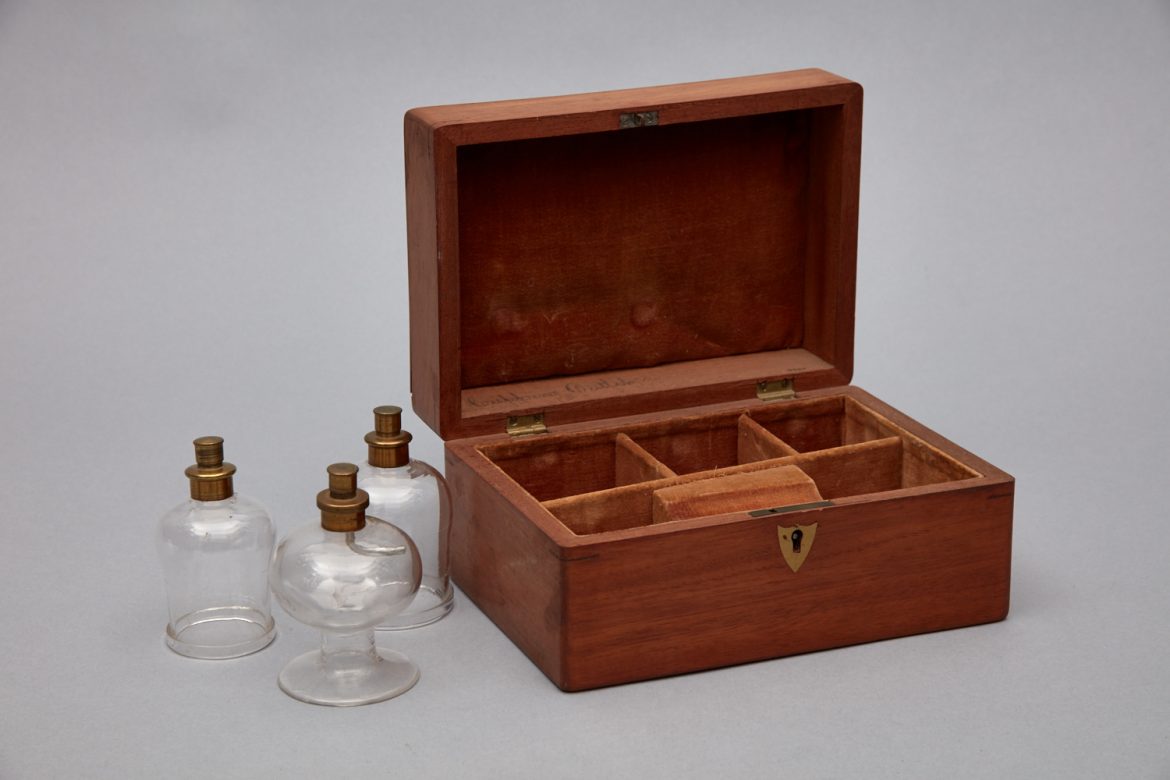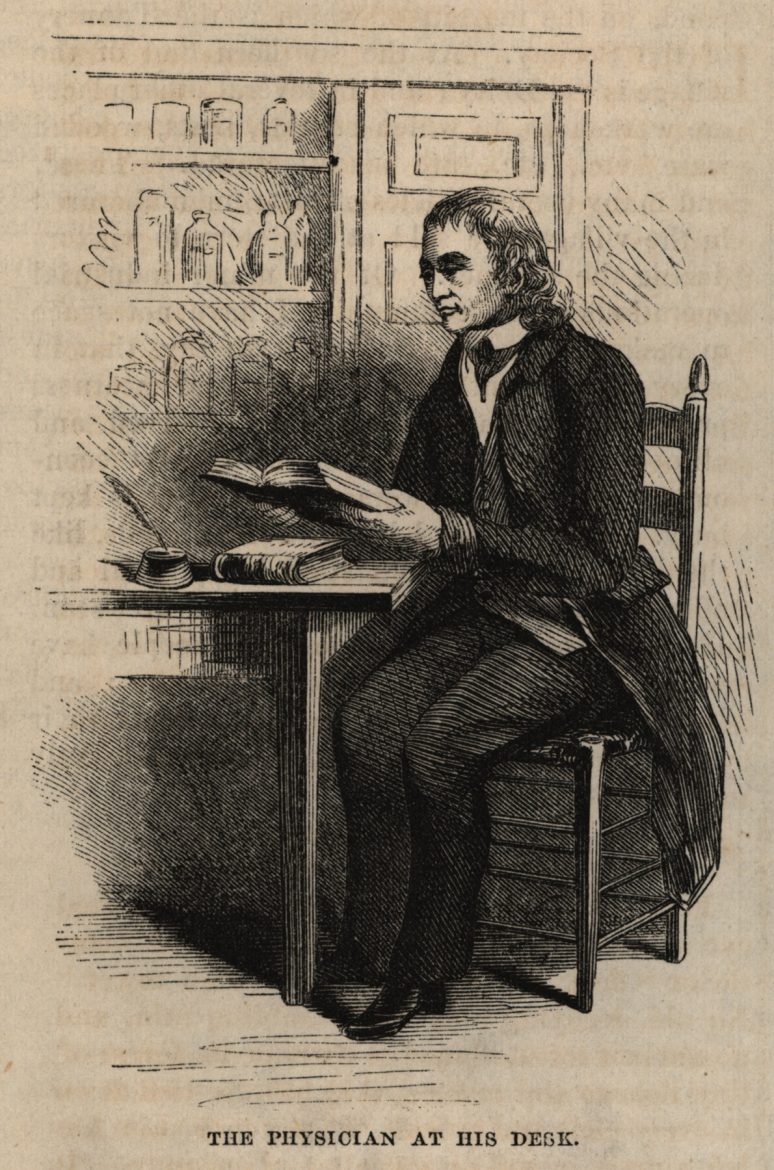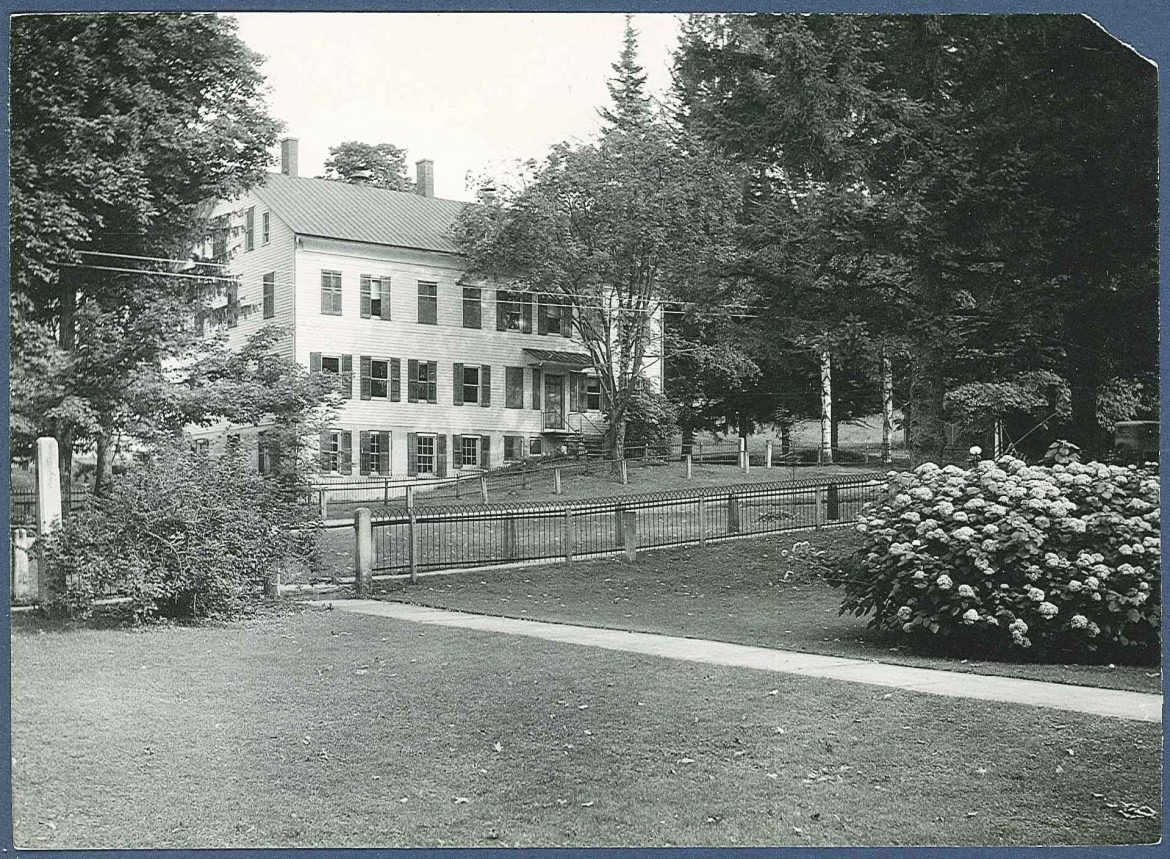
Bleeding cup set used by Brother Thomas Corbett, Canterbury, NH. Shaker Museum | Mount Lebanon 1952.4900.1a-d.
Shaker medical treatments did not differ significantly from the methods used by the world’s people. Cupping sets, bloodletting, sweating, water cures, and purges were all practiced by the Shakers.
Pictured here is a bleeding cup set, or what one user labeled as a “Cupping Outfit”. The open-ended glass vessels are capped with a brass stopcock, to which the user attached a brass syringe (not present in this set), and sometimes used a length of tubing between. The glass vessels were placed on the skin of the patient. By plunging the syringe, air pressure built up between the cup and the skin, causing blood to go to the skin and, in theory, drawing blood away from areas of inflammation. Cupping sets were used to relieve inflammation, fevers, and other ailments.
Shaker medical treatments did not differ significantly from the methods used by the world’s people. Cupping sets, bloodletting, sweating, water cures, and purges were all practiced by the Shakers. Physicians to the Shakers were appointed by the elders, and sisters took turns acting as nurses. Many Shakers who worked as doctors learned by working with more experienced practitioners among the Believers, but some Shakers trained with physicians in the world. One of those was Brother Thomas Corbett, a physician for the Canterbury, NH, Church Family, who reportedly used the bleeding cup set. Brother Thomas also directed Canterbury’s Medicine Shop, which produced the Corbett Syrup of Sarsaparilla, and directed the building of a horse-drawn hand pumper built about 1822, now in the Shaker Museum’s collection.
At Mount Lebanon, Brother Barnabas Hinckley (1808-1861) was another physician who was permitted to seek training from the world. He was appointed physician for the Church Family in 1834, and in 1858, he was awarded a medical degree from Berkshire Medical College. Like Brother Thomas, he also worked in the medicinal herb industry.

Shakers spoke proudly of the good health and longevity enjoyed by many Believers, such as Sister Dolly Sexton, of Mount Lebanon, who lived to be 107. Eldress Antoinette Doolittle of the North Family, Mount Lebanon, told journalist Hepworth Dixon that, “‘We have only had one case of fever in thirty-six years, and we are very much ashamed of ourselves for having had it, [because] it was wholly our fault.”
However, journals record many outbreaks of illnesses including colds and fevers, and cases of what was called “winter fever” (pneumonia). Sister Jane Knight of the Church Family, Mount Lebanon, wrote in January of 1834 that she and two other sisters had “not yielded as yet entirely to the influence of the prevailing epidemic, ‘bad colds,’ altho’ a well armed adversary…. It has been repelled from time to time & its violence allayed by pepper, syrups, tinctures &c. till we think it under some degree of subjection.”
Where Shaker medical care surpassed that of the world was that there were enough able-bodied adults to perform more taxing work in the stead of a Believer who was ill or injured. The sick and infirm could rest, and receive care and attention, for as long as needed, without the worry of financial loss or neglect to the duties of the farm.

Sister Mary Ann Mantle, of the Church Family, Mount Lebanon, fell and broke her leg in January of 1886, at the age of 78. In March, an “Invalid Bedstead” was acquired for her use. She died on November 4; a journal noted that she had “been a sufferer indeed, being confined to her bed all the time. Sister Anna Langford has kindly and faithfully taken care of her, which has been no small affair to do.”
Another long sufferer was Sister Hannah Ann Treadway, herself a nurse in the 1830s. She was an office trustee from 1843 to 1854, and appointed an eldress in 1855, but in September of that year resigned her duties due to illness. By June 11, 1856, she was “quite helpless,” and went to New York City to “obtain assistance from a noted cancer doctor.” She spent several months in the care of the South Family. In January of 1857, Eldress Polly Reed visited to see if she should return to her home in the Church Family, but the South Family sisters “seemed anxious to have her stay till warm weather, and appeared willing to do anything for her comfort.” Eldress Polly and other sisters continued to make visits and bring “little articles” to Sister Hannah, such that in February 1857 it was decided to “close the door of communication between her and the other families, ” in order to “give her time to rest… and see if that would not be better for her than so much visiting is.” She died in March of 1858, but the Church Family showed their appreciation for the longtime care Sister Hannah received. In 1856, Eldress Eliza Ann Taylor “prepared a fine dish for the sisters at the South Family, as a token of our unbounded gratitude for the care of Hannah Ann”; the meal included eight quarts of chicken and sweet potatoes, 30 turnover pies, and cookies, with which they were “well pleased.” In September of 1857, a long list of goods were given to the South Family including a tin bathing tub worth $5, 50 lbs of cheese, 30 lbs of beef, 6 lbs of tea, two cartloads of fire wood, walnuts, candy, and more.
With the never-ending work required of every Shaker, perhaps Believers occasionally enjoyed a stay in the infirmary. In 1874, after suffering an injury to her hand, Eldress Augusta Stone wrote, “Now for a rest from labor; kind friends tell me I shall have a good chance to read and study music.”
Examples such as this of Shaker Grace enhance my every day